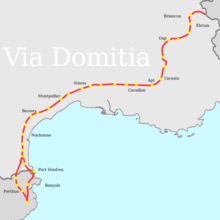
Back Via Domitia Afrikaans Даміцыева дарога Byelorussian Виа Домиция Bulgarian Via Domícia Catalan Via Domitia Czech Via Domitia Danish Via Domitia German Vía Domitia Spanish Via Domitia Basque Via Domitia Finnish
 Route of the Via Domitia | |
| Location | Briançon, France to La Junquera, Spain |
|---|---|
| Type | Roman road |
| History | |
| Builder | Gnaeus Domitius Ahenobarbus and Quintus Fabius Maximus Allobrogicus |
| Periods | 118 BC |
The Via Domitia was the first Roman road built in Gaul, to link Italy and Hispania through Gallia Narbonensis, across what is now Southern France. The route that the Romans regularised and paved was ancient when they set out to survey it, and traces the mythic route travelled by Heracles.[1]
The construction of the road was commissioned by Gnaeus Domitius Ahenobarbus, whose name it bore, following the defeat of the Allobroges and Averni by himself and Quintus Fabius Maximus Allobrogicus in 122 BCE. Domitius also established a fortified garrison at Narbo (modern Narbonne) on the coast, near Hispania, to guard construction of the road. It soon developed into a full Roman colony Colonia Narbo Martius.[2] The lands on the western part of the route, beyond the River Rhône had been under the control of the Averni who, according to Strabo, had stretched their control to Narbo and the Pyrenees.[3]
Crossing the Alps by the easiest passage, the Col de Montgenèvre (1850 m), the Via Domitia followed the valley of the Durance, crossed the Rhône at Beaucaire passed through Nîmes (Nemausus) then followed the coastal plain along the Gulf of Lion. At Narbonne, it met the Via Aquitania (which led toward the Atlantic Ocean through Toulouse and Bordeaux). Thus Narbonne was a crucial strategic crossroads of the Via Domitia and the Via Aquitania, and it was an accessible, but easily defensible port at that time. This "cusp point" in the Roman westwards expansion and ensuing supply, communication and fortification was a very important asset, and was treated as such (see Narbonne). In between the cities that it linked, the Via Domitia was provided with a series of mansiones at distances of a day's journey for a loaded cart, at which shelter, provender and fresh horses could be obtained for travellers on official business.
The route as it was in Late Antiquity is represented in schematic fashion on the Tabula Peutingeriana.
- ^ F. Benoît, "La légende d'Héraclès et la colonisation grecque dans le delta du Rhône", L'Humanité 8 (1949:104-48), noted by Fred S. Kleiner, "Gallia Graeca, Gallia Romana and the Introduction of Classical Sculpture in Gaul" American Journal of Archaeology 77.4 (October 1973:379-390) p. 381 note 20, with further bibliography.
- ^ Brennan,T.C.,The Praetorship in the Roman Republic, p. 507
- ^ Strabo, Geography, 4.2.3